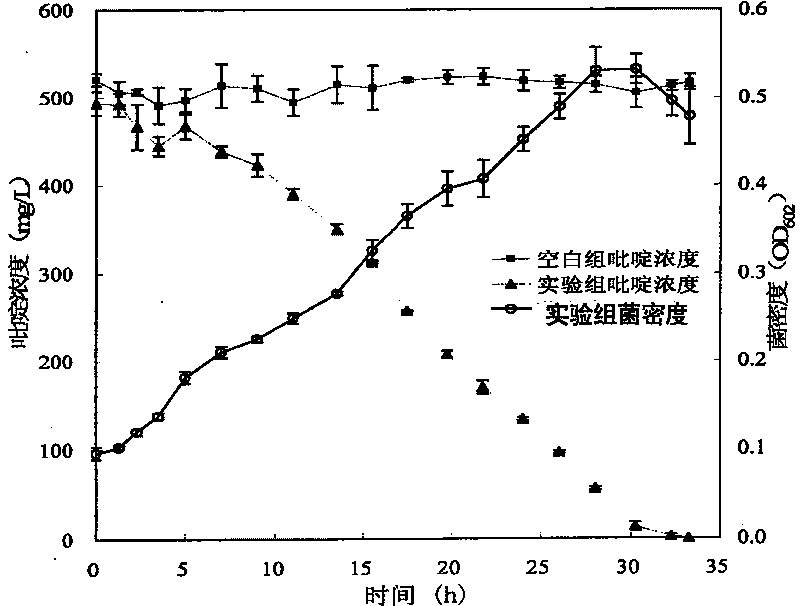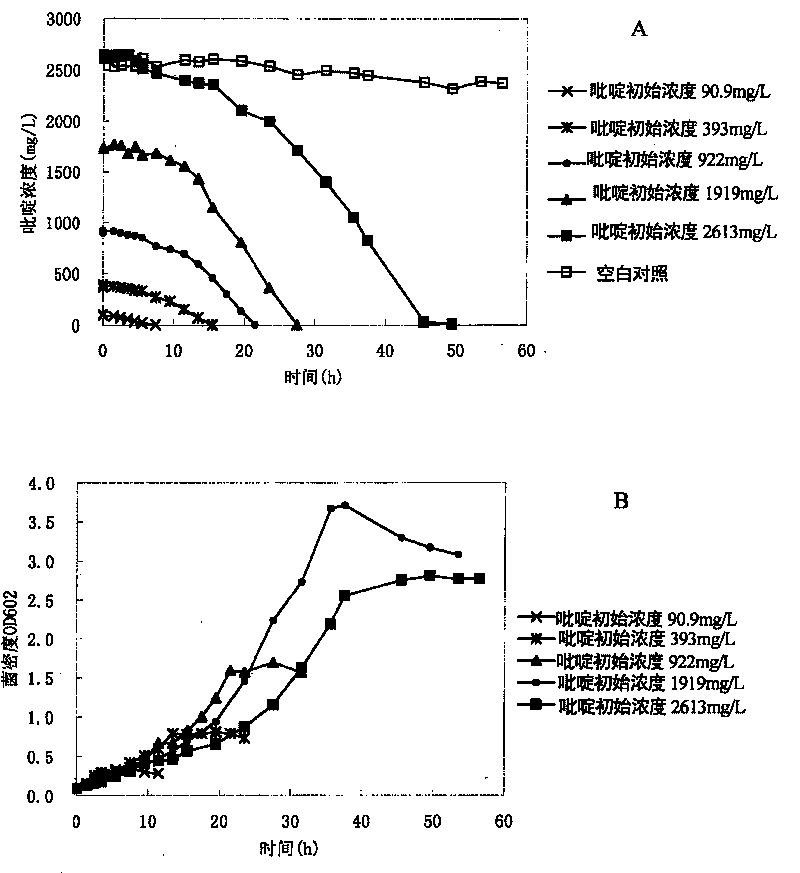Paracoccus and application thereof in nitrogenous heterocyclic compound degradation
A nitrogen heterocyclic compound, paracoccus technology, applied in the direction of microorganism-based methods, bacteria, microorganisms, etc., can solve the problems of pollution and three wastes, which are difficult to achieve effective treatment effects, and achieve fast growth rate, strong degradation activity, The effect of the simple method of cultivation
- Summary
- Abstract
- Description
- Claims
- Application Information
AI Technical Summary
Problems solved by technology
Method used
Image
Examples
Embodiment 1
[0025] Example 1. Isolation, purification and identification of Paracoccus sp. BW001 CGMCC No. 2225
[0026] 1. Isolation, purification and identification of Paracoccus sp. BW001 CGMCC №.2225
[0027] Paracoccus sp. (Paracoccus sp.) BW001 CGMCC №.2225 is a leather strain obtained from the activated sludge collected from the aeration tank of the wastewater treatment plant of the coking plant of Wuhan Iron and Steel Group, and the activated sludge was domesticated and cultivated. For Lambert-negative bacteria, the specific process of enrichment, separation and purification is as follows:
[0028] Under the condition of selective pressure pyridine 500mg / L, that is, using pyridine as the only carbon and nitrogen source, Paracoccus sp. was obtained from the activated sludge domesticated for a long time through enrichment, separation, screening, purification and other steps. BW001. The specific separation process is as follows:
[0029] The collected activated sludge samples were...
Embodiment 2
[0043] Example 2. Detection of Pyridine Biodegradation by Paracoccus sp. BW001 CGMCC №.2225 and Screening of Degradation Conditions
[0044] 1. Detection of pyridine biodegradation by Paracoccus sp. BW001 CGMCC №.2225
[0045] 1) Preparation of Paracoccus sp. BW001 CGMCC №.2225 bacterial suspension
[0046] Pick 2 rings of Paracoccus sp. BW001 cultured on the slant and inoculate them into a 250mL Erlenmeyer flask filled with 50mL LB liquid medium, culture at 30°C with shaking at 180rpm for 36h, and centrifuge at 4000rpm for 10min to collect the bacteria; then use Wash the bacterium liquid with sterile normal saline, then centrifuge, and repeat this twice, and the centrifugation condition is also 4000rpm, 10min; Finally, the gained thalline is resuspended with MSM aqueous solution to prepare a bacterium suspension (concentration is 10 8 ~10 9 cfu / mL).
[0047] 2) Detection of pyridine biodegradation by Paracoccus sp. BW001 CGMCC №.2225 Inoculate the paracoccus sp. BW001 bact...
Embodiment 3
[0063] Example 3, Plasmid Detection of Paracoccus sp. BW001
[0064] Using the improved alkaline denaturation method, the plasmid was extracted from the culture solution of BW001 bacteria. The specific plasmid extraction process was as follows:
[0065] 1. Materials used:
[0066] (1) Culture medium: LB medium
[0067] (2) Solution used for plasmid extraction:
[0068] P1: Dissolve 6.06g Tris base, 3.72g Na 2 EDTA·2H 2 O in 800 mL of distilled water, adjust the pH to 8.0 with HCl, make up to 1 L with distilled water, and add 100 mg of RNase A.
[0069] P2: Dissolve 8.0g NaOH in 950mL distilled water, 50mL 20% SDS (w / v) solution, distilled water to 1L.
[0070] P3: Dissolve 294.5 g of potassium acetate in 500 mL of distilled water. Adjust the pH to 5.5 with glacial acetic acid (about 110 mL), and distill the volume to 1 L with distilled water.
[0071] TE buffer: add 1.576g Tris·Cl per liter of distilled water to adjust the pH to 8.0; add 0.3722g EDTA·Na 2 .
[0072] 2...
PUM
 Login to View More
Login to View More Abstract
Description
Claims
Application Information
 Login to View More
Login to View More - R&D
- Intellectual Property
- Life Sciences
- Materials
- Tech Scout
- Unparalleled Data Quality
- Higher Quality Content
- 60% Fewer Hallucinations
Browse by: Latest US Patents, China's latest patents, Technical Efficacy Thesaurus, Application Domain, Technology Topic, Popular Technical Reports.
© 2025 PatSnap. All rights reserved.Legal|Privacy policy|Modern Slavery Act Transparency Statement|Sitemap|About US| Contact US: help@patsnap.com



